Sabine River Monitoring
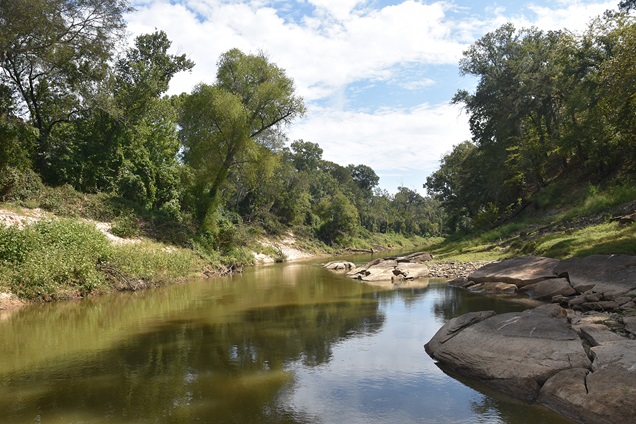
Introduction

The Sabine River Basin is approximately 300 miles long and extends from northeastern Texas to Sabine Lake and on to the Gulf of Mexico. The Sabine River and watershed provide a wide variety of recreational opportunities, such as fishing, boating, hiking and hunting to many residents and visitors each year.
Since 1982, Eastman Chemical Company, Texas Operations (TXO) has sponsored a series of biological and water quality surveys on the Sabine River near Longview, TX, by the Patrick Center for Environmental Research of the Academy of Natural Sciences of Drexel University. The present study was conducted in October of 2015; previous studies were completed in 1982, 1987, 1995, 2000, 2005 and 2010.
Study Area

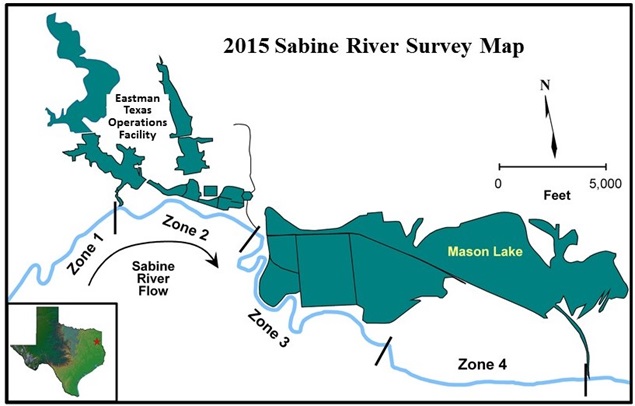
Map of the 2015 Sabine River study area and inset showing the location within the state of Texas.
Summary

-
Overall, the 2015 Sabine River surveys indicate that there was little or no significant impact on the aquatic environment from the TXO facility.
-
Water quality and the condition of biological communities in the river near Longview, TX, were broadly similar to those in 2010, 2005 and 2000 and substantially better than in 1987 or 1982.
-
These improvements in river conditions parallel improvements in TXO waste water treatment since the initial Academy study in 1982.
Environmental Chemistry

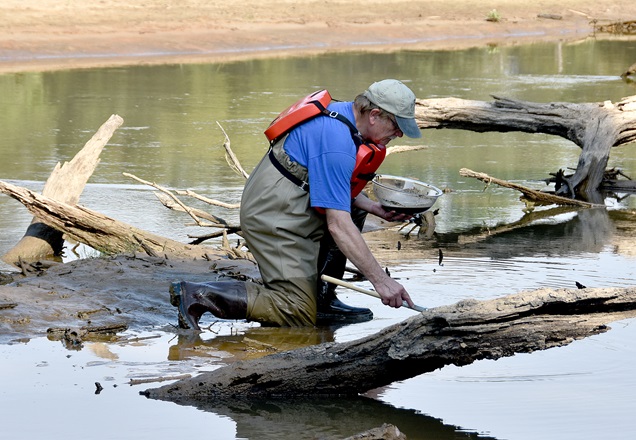
Senior chemist Paul Kiry compositing a sediment sample in Zone 4.
-
Total phosphate concentrations were slightly higher downstream of Zone 2.
-
Dissolved oxygen concentrations were sufficient for fish and macroinvertebrates.
-
In sediment samples, average concentrations of several trace metals did not show any significant trends among zones, but overall tended to be lower in 2015 compared to 2010.
-
Trace metal concentrations in mussels were variable among zones, but many decreased from Zone 2 to Zone 4. Concentrations of selected organic compounds in mussel tissue were low, but tended to be higher in Zones 3-4; the molecular composition suggests the TXO facility is a source.
-
Mercury was found in fish tissue at concentrations below the US Food and Drug Administration action level, but some fish collected (6 out of 8 Longnose Gar; 1 out of 12 Blue Catfish) had levels above the US EPA mercury guideline for fish consumption.
-
There was no consistent trend in mercury concentrations in fish tissues among zones.
-
Mercury is not used in the TXO facility, and mercury in fish tissues is a widespread condition in east Texas rivers and lakes.
-
With the exception of some fish samples, the observed concentrations of chemicals in the river (where a guideline exists) were below what is likely to have a biological effect.
Algae and Aquatic Plants

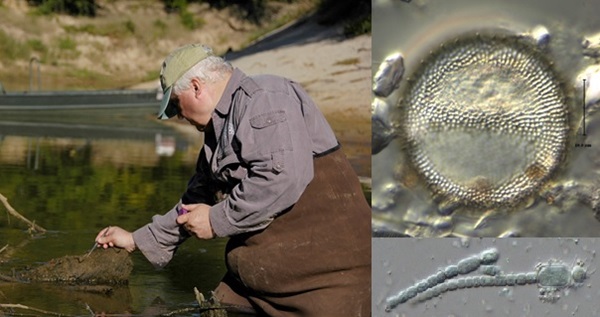
Phycologist Frank Acker collecting algae from a log. (left) Examples of some of the taxa identified include the blue-green alga Anabaena (bottom right) and the diatom Thalassiosira (top right).
-
Large patches of diatom growths dominated the algal communities in all zones. Growths of filamentous green and blue-green algae were less prevalent in 2015 compared to the 1995-2010 studies, especially in the zones below the TXO facility.
-
There were indications of nutrient enrichment throughout the study area, similar to previous studies in 1995-2010, but much reduced from earlier surveys in 1982-1987.
Macroinvertebrates

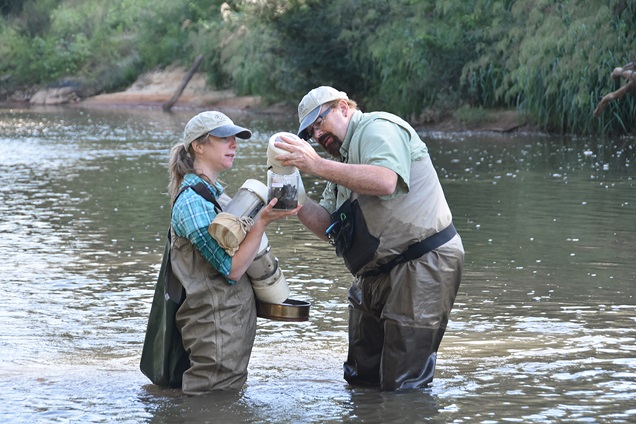
Aquatic ecologists, Dr. Stefanie Kroll and Brett Marshall (l. to r.), examining a stream bottom sample collected using a T sampler.
|
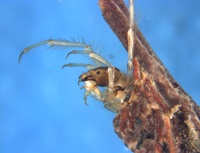
Aquatic insects, like this Nectopsyche caddisfly, are important components of the Sabine River aquatic ecosystem.
|
Aquatic Insects
-
In 2015, the study area supported more diverse insect assemblages than in any previous survey, some of which may be due to habitat improvements at Zone 2.
-
It appears that the aquatic insect fauna recorded in 2015 were more similar among zones than seen in 2010.
-
The 2015 analysis of aquatic insects indicated that the communities may be more robust downstream, possibly due to habitat improvements and a decline in species richness upstream at Zone 1.
|
Non-Insect Macroinvertebrates

Dr. Raymond W. Bouchard, Jr. holding two washboard mussels. Freshwater mussels and crayfish are two of the many different kinds of non-insect macroinvertebrates found during the 2015 Sabine River studies.
-
Similar to 2010, water levels were lower than during previous studies, which may have impacted the number of different kinds of macroinvertebrates collected during the survey in 2015.
-
48 taxa were recorded in 2015, including five new to the study, the highest across all surveys.
-
Freshwater mussel diversity remained stable and included three threatened species in Texas: Texas pigtoe, sandbank pocketbook, and the Texas heelsplitter.
-
The 2015 non-insect macroinvertebrate survey did not reveal any substantial impacts from TXO operations.
-
In the most recent surveys (1995-2015), differences in the non-insect macroinvertebrate fauna among zones and surveys have been related to variability in habitats and river flows.
Fish

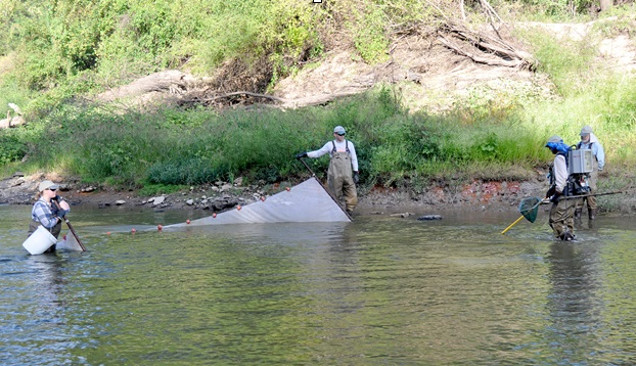
Allison Stoklosa, Dave Keller, Paul Overbeck, and Dr. Richard Horwitz (l. to r.) using a backpack electrofisher to collect smaller fish in shallow water at Zone 4.
|

Many fish species were recorded
during the 2015 study
including the Longear Sunfish
pictured above.
|
-
Over 22,000 fish (46 different species) were caught in the 2015 survey. The Green Sunfish was a new species that had not been caught in any previous Academy survey.
-
Roughly similar numbers of fish species were counted in each zone.
-
There were differences in abundances of some fish species among zones; these results could reflect a response to the facilities output, which may increase productivity and food supply.
-
Overall, the analysis of fish abundance and species richness revealed no appreciable impacts on the Sabine River fish assemblage due to TXO operations
|
|
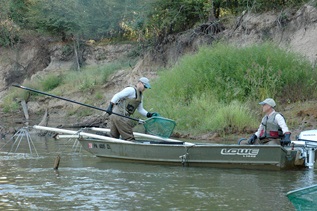 Fisheries biologists Dave Keller and Paul Overbeck boat electrofishing to collect fish for the 2015 study. Fisheries biologists Dave Keller and Paul Overbeck boat electrofishing to collect fish for the 2015 study.
|
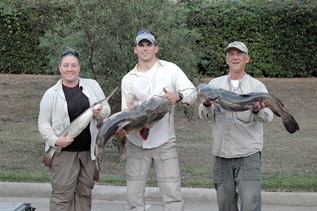 Longnose Gar and Flathead Catfish being held by Allison Stoklosa, Dave Keller and Paul Overbeck. Longnose Gar and Flathead Catfish being held by Allison Stoklosa, Dave Keller and Paul Overbeck.
|